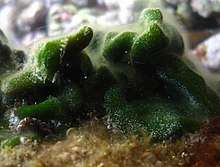Codium spongiosum
Codium spongiosum is a species of seaweed in the Codiaceae family.[1]
| Codium spongiosum | |
|---|---|
 | |
| Codium spongiosum in a lagoon on Réunion | |
| Scientific classification | |
| Phylum: | Chlorophyta |
| Class: | Ulvophyceae |
| Order: | Bryopsidales |
| Family: | Codiaceae |
| Genus: | Codium |
| Species: | C. spongiosum |
| Binomial name | |
| Codium spongiosum | |
The light green thallus has an applanate to pulvinate habit and is usually around 10 to 25 centimetres (3.9 to 9.8 in) across and 2 centimetres (0.8 in) thick.[1] It has irregular lobes and moderately firm while alive becoming more spongy once dead. The utricles form in large clusters and are 2 to 6 millimetres (0.079 to 0.236 in) long and coated in many hairs.[2]
The species is similar to Codium lucasii which adheres more tightly to rock surfaces.[3]
It is epilithic in the subtidal to intertidal zones.[1] Mostly situated in calmer waters from the low tide mark to several metres depth. It is often found in warmer waters but has a scattered distribution in colder waters.[2]
The species was first formally described by the botanist Harvey in 1855 in Some account of the marine botany of the colony of Western Australia, published in the Transactions of the Royal Irish Academy.[4] The type specimen was collected from King George Sound along the south coast of Western Australia.
In Western Australia is found along the coast in the Kimberley and as far south as the Recherche Archipelago.[1] It is also found along South Australian coasts on the Eyre Peninsula, Yorke Peninsula, Kangaroo Island and Fleurieu Peninsula.[2] It is common in all tropical and subtropical waters.
References
- "Codium spongiosum". FloraBase. Western Australian Government Department of Parks and Wildlife.
- "Codium spongiosum Harvey 1855c:565; 1858: pl. 55". Electronic Flora of South Australia Species Fact Sheet. Government of South Australia. Retrieved 1 September 2017.
- "Codium spongiosum Harvey" (PDF). South Australian Herbarium. Retrieved 1 September 2017.
- Guiry, M.D. & Guiry, G.M. (2017). "Codium spongiosum Harvey". AlgaeBase. National University of Ireland.